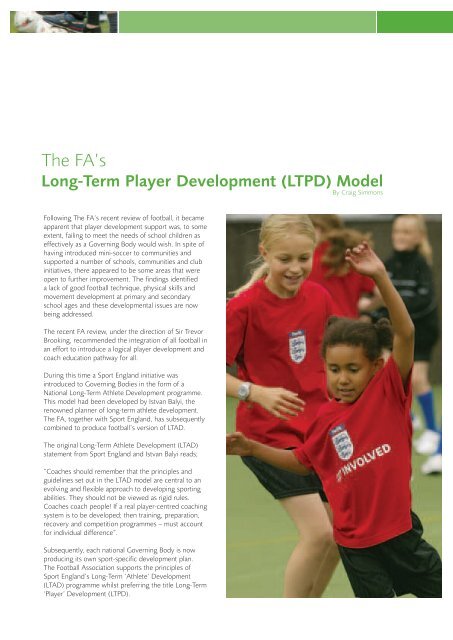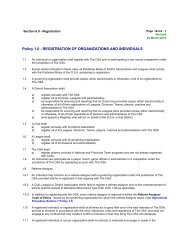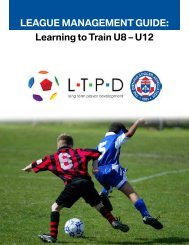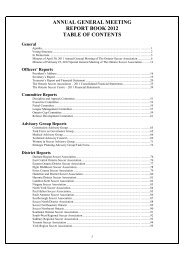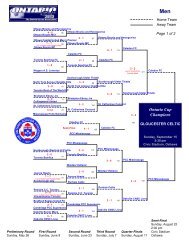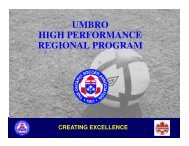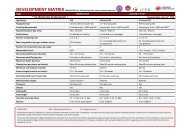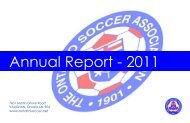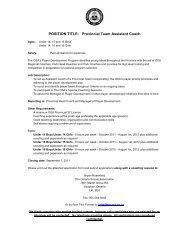The FA's Long-Term Player Development - Ontario Soccer Association
The FA's Long-Term Player Development - Ontario Soccer Association
The FA's Long-Term Player Development - Ontario Soccer Association
Create successful ePaper yourself
Turn your PDF publications into a flip-book with our unique Google optimized e-Paper software.
<strong>The</strong> FA’s<strong>Long</strong>-<strong>Term</strong> <strong>Player</strong> <strong>Development</strong> (LTPD) ModelBy Craig SimmonsFollowing <strong>The</strong> FA’s recent review of football, it becameapparent that player development support was, to someextent, failing to meet the needs of school children aseffectively as a Governing Body would wish. In spite ofhaving introduced mini-soccer to communities andsupported a number of schools, communities and clubinitiatives, there appeared to be some areas that wereopen to further improvement. <strong>The</strong> findings identifieda lack of good football technique, physical skills andmovement development at primary and secondaryschool ages and these developmental issues are nowbeing addressed.<strong>The</strong> recent FA review, under the direction of Sir TrevorBrooking, recommended the integration of all football inan effort to introduce a logical player development andcoach education pathway for all.During this time a Sport England initiative wasintroduced to Governing Bodies in the form of aNational <strong>Long</strong>-<strong>Term</strong> Athlete <strong>Development</strong> programme.This model had been developed by Istvan Balyi, therenowned planner of long-term athlete development.<strong>The</strong> FA, together with Sport England, has subsequentlycombined to produce football’s version of LTAD.<strong>The</strong> original <strong>Long</strong>-<strong>Term</strong> Athlete <strong>Development</strong> (LTAD)statement from Sport England and Istvan Balyi reads;“Coaches should remember that the principles andguidelines set out in the LTAD model are central to anevolving and flexible approach to developing sportingabilities. <strong>The</strong>y should not be viewed as rigid rules.Coaches coach people! If a real player-centred coachingsystem is to be developed; then training, preparation,recovery and competition programmes – must accountfor individual difference”.Subsequently, each national Governing Body is nowproducing its own sport-specific development plan.<strong>The</strong> Football <strong>Association</strong> supports the principles ofSport England’s <strong>Long</strong>-<strong>Term</strong> ‘Athlete’ <strong>Development</strong>(LTAD) programme whilst preferring the title <strong>Long</strong>-<strong>Term</strong>‘<strong>Player</strong>’ <strong>Development</strong> (LTPD).
Coaching<strong>The</strong> recent FA review, under thedirection of Sir Trevor Brooking,recommended the integrationof all football in an effort tointroduce a logical playerdevelopment and coacheducation pathway for all.Moving Forward<strong>The</strong> FA’s reaction to the review findings has been toincrease the support available to those practitioners andsupporters who work with children. <strong>The</strong> concept of aplayer development pathway is being produced in linewith the ongoing coach education review for the coach,teacher and parent. This initiative will integrate LTPDinto existing courses in all disciplines and levels ofqualification (Table 1). <strong>The</strong> process aligns with all otherinformation avenues which support the courses shownin Table 1 and includes technical, physical,psychological and social development.Table 1: INTEGRATION OF LTPD INTO EXISTINGCOURSES ACROSS DISCIPLINES AND LEVELSTECHNICALPHYSICALPSYCHOLOGYSOCIALUEFA Pro LicenceUEFA ‘A’ LicenceUEFA ‘B’ Licence1st4Sport Level 21st4Sport Level 1Goalkeeping 1 - 4FA Youth CoachesFitness TrainersFA & ScUK Skills CoachOnline FitnessTreatment of Injury.First AidEmergency AidLevel 5Level 4Level 3Level 2Level 1Online CoursesChild Protection<strong>Soccer</strong> ParentDrug AwarenessEquity and EthicsDiversity AwarenessRacism AwarenessGiven the diversity of participation in football, <strong>The</strong> FAhas decided to adopt an eight-stage model of <strong>Long</strong>-<strong>Term</strong> <strong>Player</strong> <strong>Development</strong> as shown in Table 2 (overleaf).This example shown describes an age appropriatedevelopment pathway over time.<strong>The</strong> recommendations for the younger age groups arein accord with the schools age group categories:• Primary school ages (small-sided games played)stages 1 and 2.• Secondary school ages (11 v 11 games played) stages3 and 4.• School leaver age groups are represented in stages5 and 6.• Stage 7 produces the mature player example.• Stage 8 refers to any participant who is retainedwithin football.VISIT INSIGHT www.<strong>The</strong>FA.com/FALearningINSIGHT SPRING 2005 15
Building flexibility around the model accommodatesthe diverse needs of all players and support staff, whilstthe central model offers the foundation for the variedstrands of participants. Eg. schools, counties,communities, professional clubs, disability teams,futsal, free play etc.All have the opportunity for developing their ownparticular <strong>Long</strong>-<strong>Term</strong> <strong>Player</strong> <strong>Development</strong> strand of thecentral programme with support from the NationalGoverning Body. As such, <strong>The</strong> Football <strong>Association</strong>presents a model which supports a fully inclusiveparticipation policy for all.<strong>Term</strong>inology within the LTPD model: Eg.FUNdamentals - Learning to Train - Training to TrainTraining to Compete 1 - Training to Compete 2 -Training to Win 1 - Training to Win 2 - Retention.Are simply descriptors of a progressive developmentpathway over time.(Full explanations for these terms can be found withinthe suggested reading following the summary.)<strong>The</strong> Football <strong>Association</strong> Introduction to <strong>Long</strong>-<strong>Term</strong> ‘<strong>Player</strong>’ <strong>Development</strong> (LTPD)<strong>The</strong> FA LTPD model consists of eight stages.Its flexibility allows for varied strands of participation,ongoing change and varied levels of ability and maturity.Table 2: LONG-TERM ‘PLAYER’ DEVELOPMENT (LTPD)Key IssuesResearch has shown that young children in sport areexposed to unreasonable amounts of competition withtoo little practice time being made available. Thiscircumstance invariably denies quality techniquedevelopment and reduces the physical movementbenefits that sporting practice time offers.Psychological and social development may also beadversely affected by this over-competitive process.<strong>The</strong> FA <strong>Long</strong>-<strong>Term</strong> <strong>Player</strong> <strong>Development</strong> model indicatesthat time spent in primary school age practice comparedto games should ideally produce a ratio of four partspractice time to one part competitive small-sided gametime. Progressing at secondary school age to a ratio of,eg, two or three parts practice time to one part 11 v 11game time. Balancing these activities requires localinformation and consideration of the needs of theplayers concerned.<strong>The</strong> ratios suggested are not prescriptive but reflectexamples of learning environments which offer playersvaried opportunities for development.In addition to increased quality practice time,‘periodisation’ is also considered. This term stronglyrecommends annual planning programmes which allowfor specialised development periods designed to meetindividual needs. <strong>The</strong>se building blocks are consideredfundamental to long-term benefits.STAGES 1 AND 2STAGES 3 AND 4STAGES 5 AND 6STAGES 7 AND 81. FUNdamentals(FUNdamentals)5 to 8 years oldAges may overlap ±3. Developing practice(Training to Train)11 to 14 years oldAges may overlap ±5. Training forcompetition(Training to Compete 2)16 to 18 years oldAges may overlap ±7. Training to win(Training to Win 2)20 years old plusAges may overlap ±2. Enjoying practice(Learning to Train)8 to 11 years old4. Understandingcompetition(Training to Compete 1)14 to 16 years old6. Developing winning(Training to Compete 1)18 to 20 years old8. Retaining peoplein football(Retention)Any age appliesPRIMARY SCHOOL AGESECONDARY SCHOOL AGESECONDARY SCHOOL AGEMATURE ADULT AGE(Adapted from Balyi, Hills, Simmons and Way 2003)
Coaching<strong>The</strong> model has at its core a picture of age and maturityappropriateactivity. Beginning with actual age(chronological), this aspect also takes account of varyingmaturity status and the impact this has in groups ofmixed ability players.What Occurs and When<strong>The</strong> occurrences shown in Table 3 are self-explanatoryexamples of the first six stages of the model and are notconsidered complete or rigid. <strong>The</strong>y reflect different agesand stages of development which demonstrateappropriateness and windows of opportunity for thefour disciplines.<strong>The</strong> younger age groups demonstrate significantdevelopmental changes compared to the 20-year-oldplus ages and as such are the examples withinthese tables.All have the opportunityfor developing their ownparticular <strong>Long</strong>-<strong>Term</strong><strong>Player</strong> <strong>Development</strong>strand of the centralprogramme with supportfrom the NationalGoverning BodyTable 3: EXAMPLES OF THE FIRST SIXSTAGES OF LTPDPRIMARYSCHOOL AGE5 to 11 years old(BY DATE OF BIRTH)Chronological agehas to take accountof the variability ofgender, ability,maturation and thedevelopmental needsof the individualIn 2 LTPD Phases5 - 8 & 8 - 11TECHNICALBasic Techniques“Ball and the wall”activitiesImproving Basic skillsGroup practiceGames as theteacherInterchange ofpositionsInvasion gameprinciplesPlaying other sportsPHYSICALA. B. C. s -Agility. Balance.Co-ordination. SpeedK. G. B. -Kinesthesia(movement).Gliding (ice & snowetc) Buoyancy (water)C. P. K. - Catching.Passing. Kicking.R. J. T. - Running.Jumping. ThrowingMotor control. Multiskills.Mixed activitiesPSYCHOLOGICALEnthusiasmImagination &ExplorationAvoiding anxiety andboredomProgressiveintroduction tomental skillsProgressive groupactivitiesUnderstandinggamesSOCIALFun and enjoyment.Support from parents,schools and clubs.Inclusion andparticipation.Form relationships.Safe environment.Simple rules andethics.Group behaviour canbe influenced as afoundation.VISIT INSIGHT www.<strong>The</strong>FA.com/FALearningINSIGHT SPRING 2005 17
SECONDARYSCHOOL AGE11 to 16 years old(by date of birth)Chronological agehas to take accountof the variability ofgender, ability,maturation and thedevelopmental needsof the individualIN 2 LTPD PHASES11 - 14 & 14 - 16TECHNICALRefining techniquesSkill execution underpressureAttacking &Defending principlesIntroduction totactics and teamworkRotationPHYSICALAdolescent growthspurtAerobicdevelopmentChanging shape.Early / latematurationAthleticism changesIncreasing variationbetween playersPSYCHOLOGICALSelf conceptAwarenessResponsibilityGoal settingConfidenceCoping strategiesSOCIALAccept responsibilityFair playPeer group featuresValues and beliefsAppropriatebehavioursPersonal and groupresponsibilitiesSCHOOLLEAVER AGE16 to 20 years old(by date of birth)Chronological agehas to take accountof the variability ofgender, ability,maturation and thedevelopmental needsof the individualIN 2 LTPD PHASES16 - 18 & 18 - 20TECHNICALBecoming technicallyproficientExecuting the correcttechnique ondemandContributing to teamplay involving space& timeProducing thetechniques requiredto support bothdefending &attacking strategiesPHYSICALMuscle mass gains.Strength improves.Power increases.Lactate training.Improving recovery.Full potential isprogressivelyachieved.PSYCHOLOGICALLifestyle skills.Developing a stabletemperament.Understanding matchplay.Communication.Advanced copingstrategies aredeveloped.SOCIALDevelopingemotional stability.Being sociallyresponsible.Recognising culturaldifferences.Dealing with conflict.Appreciating others.<strong>The</strong> example shown below would appear to be a logicaldescription of a suitable foundation for progress.<strong>The</strong> football player at primary school age can start toexperience LTPD within these three simple features.1. Skill acquisition – <strong>The</strong> three interwoven phases are:I. Technique development – mastering the ballII. Physical development – athletic movementIII. Combining and effectively executing the correcttechnique, movement and decision on demand.2. For the coach in a football context two factors toavoid are ‘Anxiety and Boredom’.• Anxiety may occur primarily when the coach expectstoo much from young players• Boredom may occur when the coach expectstoo little.3. <strong>The</strong> priorities for the primary school aged player are:• To have fun and improve their techniques• To develop their movement and discover the benefitsof learning.Surely this applies at all ages!
CoachingQuestionHow will these principles be maintained throughout thegolden age of learning?One answer may be found in the effective education ofquality skills coaches:• <strong>The</strong>se practitioners can provide the enjoyable andchallenging environments in which the playersdevelop their techniques.• This atmosphere can also offer opportunities forimproving the players’ movement skills whilst learningfrom a range of experiences.With this in mind, the ideal scenario for both short andlong-term player development is to meet the individualdevelopmental needs of the players as often and asrealistically as possible.SummaryLTPD is in accord with the schools physical educationand sports programmes which provide opportunities forchildren to experience a multi-sport environment beforethey choose their preference – hopefully football.This choice of sport will to some extent dependon the impression the children have during theirfootball activity.Additional information is available through:• <strong>The</strong> Sports Coach UK (ScUK) LTAD booklet titled“Coaching for <strong>Long</strong>-term Athlete <strong>Development</strong>”ISBN - 13: 978-1-902523-70–9ISBN - 10: 1-902523-70 -9• From their skills courses which can be found atwww.sportsCoachuk.org• Sports Coach UK (ScUK) Phone; 0113 274 4802Craig Simmons has been making a significantcontribution to <strong>The</strong> Football <strong>Association</strong> CoachEducation programme since 1972. He has beeninvolved all aspects of development and performancerelated to the maturing young player. In 1997 he wasappointed as <strong>Player</strong> <strong>Development</strong> Adviser to <strong>The</strong> FAwhich opened a new career pathway including aMasters Degree in Sports Science. This backgroundhas supported extensive involvement in all aspects ofplayer development. He is currently focused on therecently introduced ‘<strong>Long</strong>-<strong>Term</strong> <strong>Player</strong> <strong>Development</strong>’(LTPD) model which supports all football in Englandand is described within this article.Your contribution to this emerging programme iswelcome. Please feel free to forward your ideas onthis subject to: Craig.Simmons@<strong>The</strong>FA.com<strong>The</strong>refore, it is in everyone’s interest in football tomake this participation as enjoyable as possible and tothe point where children are motivated to come backfor more.Acknowledgement: Bayli, Hills, Simmons and Way 2003Note: Examples of player development issues in thisarticle are addressed in a general manner. It isrecognised that specific needs of children requireindividual reviews at a personal and local level.Views expressed are with awareness in mind. <strong>The</strong>y arenot prescriptive in any way and are demonstrating themany alternatives available.VISIT INSIGHT www.<strong>The</strong>FA.com/FALearningINSIGHT SPRING 2005 19


